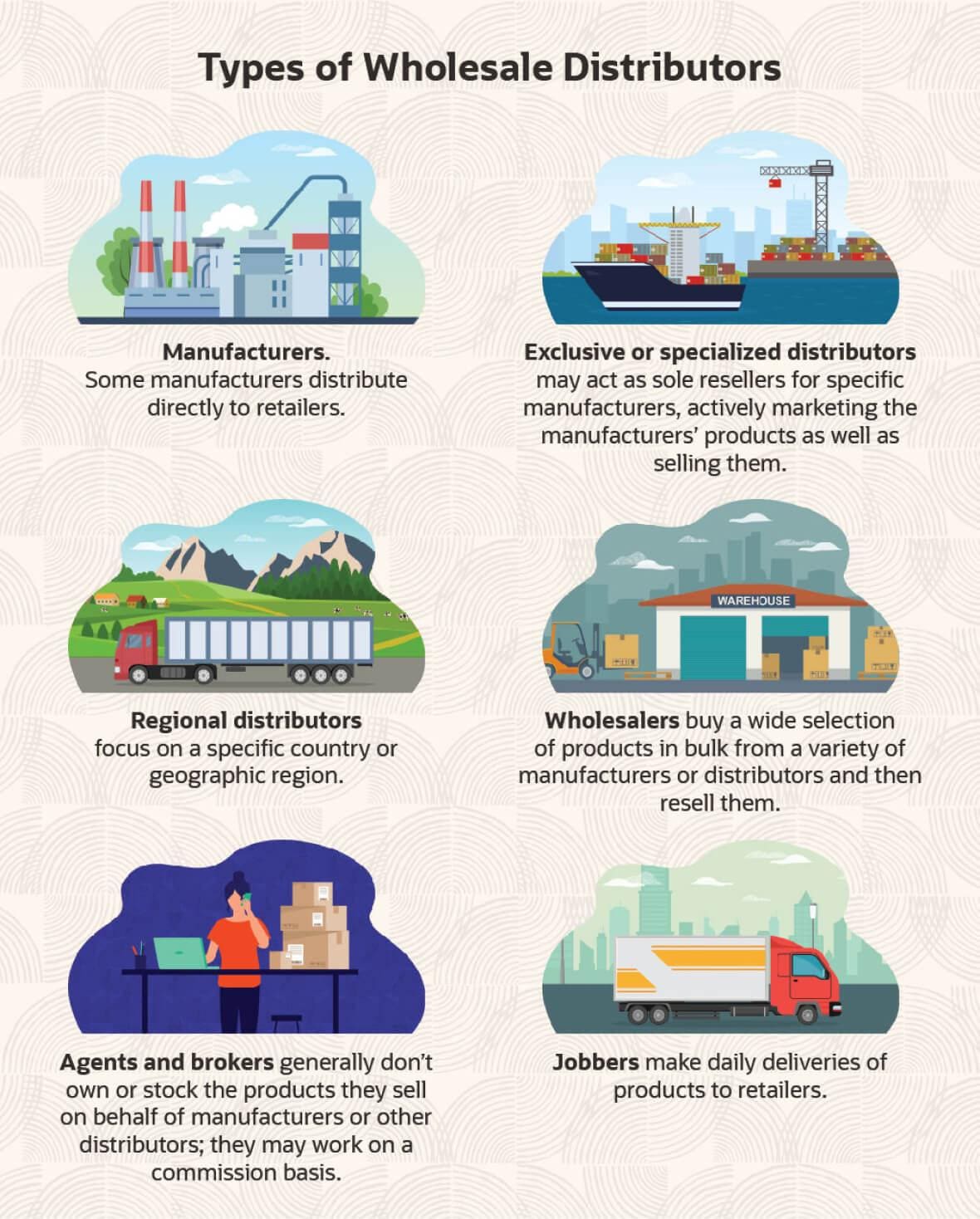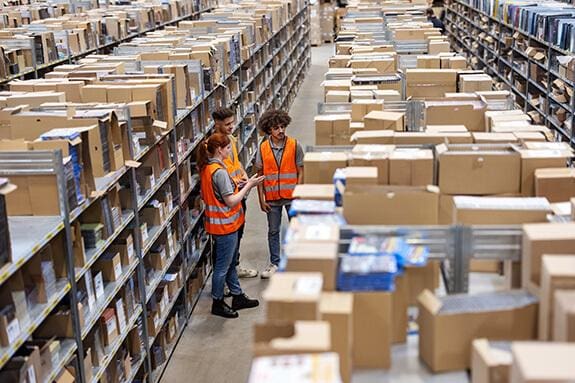Wholesale distributors play a vital middleman role in the journey of products from the production line to their final customer. By purchasing goods in bulk from manufacturers and distributing them to retailers, they make sure stores have products to sell while enabling manufacturers to focus on designing and building innovative products. Wholesale distribution businesses often specialize in specific industries or product categories and sometimes develop long-term relationships with manufacturers.
Wholesale distribution plays a significant role in the economy as well, accounting for approximately 410,000 establishments with a combined annual sales of about $9 trillion in the U.S. alone (opens in new tab), according to a First Research report. Wholesale distributors also are experiencing rapid change due to a number of factors: new competition, the growth of ecommerce and rising customer expectations, among them.
What Is Wholesaling or Wholesale Distribution?
Wholesalers operate as middlemen between product manufacturers and retailers or other businesses. They make a profit by buying products in bulk at a discount and reselling them in smaller quantities at a higher price to individual retailers. Many distributors specialize in specific industry sectors or product categories and build up a great deal of valuable industry expertise. This helps them provide value to their suppliers and customers, while distinguishing themselves from competitors.
Wholesale vs. distribution
The terms “wholesaler” and “distributor” are sometimes used interchangeably to describe any company that buys products from manufacturers and sells them to retailers and other businesses (as opposed to selling directly to consumers). However, the term “distributor” is often applied more specifically to a narrower subset of companies that have long-term relationships with particular manufacturers and help market and support their products.
Other common names for wholesalers and distributors
To further muddy the waters, the way wholesalers and distributors are described can vary by industry and product. Some of the other common labels include:
- Supply house
- Importer/exporter
- Dealer
- Jobber
- Buying/selling group
- Trading company
Key Takeaways
- Wholesalers play vital roles in the supply chain for most products, buying goods in bulk from manufacturers and selling them to retailers and other businesses.
- Wholesale distributors are responsible for acquiring goods, storing them, preparing them for sale to their customers and then delivering them.
- Some distributors have strong relationships with specific manufacturers, acting as their representatives in some markets and supporting their marketing efforts.
- Working with wholesalers can provide retailers and ecommerce sellers with discount pricing, more consistent product supply and wider product variety.
- Challenges facing wholesale distributors include new kinds of competition, direct-to-consumer sales models and rising customer expectations.
Wholesale Distribution Explained
Historically, relatively few manufacturers have sold their products directly to retailers or consumers. Wholesale distributors provide that liaison, buying large quantities of products from manufacturers, storing them and then supplying them to retailers and other businesses. This enables manufacturers to focus on designing, building and marketing their products without investing in extensive sales efforts or managing relationships with a large number of small retailers. Wholesalers often stock a wide range of products, which makes life simpler for retailers because they can obtain a broad variety of goods without the added complexity of working with many different suppliers.
Some industries have several levels of distribution, with larger wholesale distributors focusing on supplying smaller, regional or specialist distributors. Some wholesalers also act as suppliers of raw materials to manufacturers.
How Does Wholesale Distribution Work?
Wholesale distributors are responsible for acquiring goods, storing them, preparing them for sale in smaller quantities to their customers and then delivering them.
Success in wholesale distribution hinges on gaining a good understanding of customer needs, market trends, costs and price points; building strong relationships with business partners; and maximizing operational efficiency. Wholesale distributors must build solid “upstream” relationships with the suppliers or manufacturers of the goods they buy in bulk. They must also develop trusted relationships with their own “downstream” customers, be they retailers or businesses like restaurants, contractors or hospitals.
In some cases, wholesalers may serve as dropshipping providers for brick-and-mortar or ecommerce retailers. In a dropshipping arrangement, the retailer doesn’t actually stock the product it sells to customers. Instead, the retailer accepts payment and then passes the order to the distributor, which ships the product directly to the customer.
The Role of Wholesale Distribution
Wholesale distributors help manufacturers reach a wider market for their products, while providing retailers with access to a diverse range of products from a single source. In doing so, these intermediaries play three main roles:
- Storage and inventory management: By storing and managing inventory in their distribution centers, wholesalers ensure that products are readily available for retailers to purchase and restock as needed. This also keeps manufacturers’ focus on production rather than having to work directly with end customers.
- Streamlining the supply chain: Distributors simplify the supply chain by housing products from various manufacturers, so that retailers can access a wide range of goods from one place, without having to manage multiple relationships and orders from individual manufacturers. This consolidation reduces complexity and increases efficiency in the supply chain.
- Additional services: By offering value-added services, wholesale distributors can better support manufacturers, develop stronger relationships with retailers and distinguish themselves from the competition. Such services can include product customization, packaging, labeling and marketing. Some distributors also provide technical expertise, product training and after-sales support.
Types of Wholesale Distributors
A variety of companies can be involved in wholesale distribution, even within a single market or industry sector. Some of these participants include:
- Manufacturers: In addition to making products, some manufacturers distribute them to retailers. This is especially true of boutique manufacturers, which also may sell directly to consumers. But large companies do this, too, and sometimes find themselves competing with traditional distributors.
- Exclusive or specialized distributors: Some distributors act as the sole resellers for specific manufacturers. They often help analyze the marketplace and actively market and sell the manufacturers’ products as well.
- Regional distributors: These companies focus on a specific country or geographic region. They bring valuable regional knowledge of customer preferences, languages, trends, regulations and import procedures. They may have exclusive rights to distribute products in their territory.
- Wholesalers: In some industry sectors, wholesalers are differentiated from distributors, partly because they don’t represent specific manufacturers. They buy a wide selection of products in bulk from a variety of manufacturers or distributors and then resell them. They focus on competitive pricing, storage and order fulfillment.
- Agents and brokers: Agents generally don’t own or stock the products they sell; instead, they focus on finding customers, negotiating pricing and making the sale on behalf of the manufacturers or distributors that supply the products. They may work on a commission basis.
- Jobbers: In some sectors, individuals or small companies — jobbers — make daily deliveries of products to retailers.

Wholesale vs. Retail Distribution
The main difference between wholesale and retail lies in the type of buyer that these two distribution channels target. Other distinctions include how much they purchase at one time, their pricing strategies and how much they interest with end customers.
Wholesale distributioninvolves selling bulk quantities of goods to retailers and other distributors. Wholesalers typically purchase products directly from manufacturers at discounted prices due to their large-volume orders. They store these goods in warehouses before reselling them to clients. While wholesalers often pass along some of their savings in the form of lower prices, they have limited interaction with end consumers.
Retail distributionfocuses on selling products directly to end consumers in smaller quantities. Retailers purchase goods from wholesalers and sell them at a higher price to cover their costs and generate a profit. They often have physical storefronts or online platforms where customers can browse and purchase products, and they prioritize providing an engaging shopping experience and excellent customer service. (Of course, they can buy directly from manufacturers, too.)
Benefits of Wholesale Distribution
Wholesale distribution provides advantages for all businesses involved in the supply chain, including manufacturers and retailers. Those benefits include:
- Increased reach: Manufacturers that work with wholesale distributors can invest less to expand their market, since the wholesaler is responsible for distributing the product to far-flung retailers. Manufacturers don’t need to hire, develop or maintain expensive armies of salespeople with the expertise to sell directly to customers.
- Simpler operations: Wholesalers simplify business operations for both manufacturers and retailers. Manufacturers can work with a relatively small number of distributors to fulfill several large orders, instead of many small ones. And retailers can get their supplies from just a few distributors, instead of dealing with many individual manufacturers, thus simplifying ordering and reducing shipping costs.
- Lower cost of business: Because wholesale distribution simplifies operations for manufacturers and retailers, it can also reduce their operating costs. Retailers that buy from wholesalers may also pay lower prices than when buying small quantities directly from manufacturers.
- Storage capability: Wholesalers often have extensive warehouse capacity for storing inventory, freeing manufacturers and retailers from the burden and cost of maintaining large stocks of products.
- Supply chain stability and mitigation of risk: By buying and maintaining inventory, wholesalers help secure a stable supply of products and reduce risk of shortages for other companies in the supply chain.
Wholesale Distribution Challenges
Wholesale distribution has been the dominant model for connecting manufacturers and retailers since the dawn of the industrial age. However, wholesale distributors currently face challenges on several fronts:
- New competitors: Established wholesale distributors face growing competition from online entities. These include online retailers and marketplaces moving into business-to-business (B2B) sales, using their scale and existing platforms to offer low-cost products, transparent pricing and fast shipping. Adding to the competition, overseas suppliers can sell internationally using online stores, often undercutting domestic distributors.
- Manufacturers selling direct: Some manufacturers are opting to sell directly to consumers, either online or via their own retail channels, both to increase their profit margins and to maintain greater control over their brand and customer experience.
- Rising customer expectations: Distributors need to meet increased customer expectations, which have been fueled by retail ecommerce experiences: fast delivery, real-time visibility into orders and delivery status, and 24/7 customer service.
- Profit pressure: In an era of global trade, the downward pressure on prices — particularly for commodity goods — is tremendous. Shrinking margins force distributors to increase operating efficiency, another form of pressure.
Wholesale Distribution Industries
Wholesale distributors tend to specialize in an industry or product category. This enables them to deal effectively with nuances unique to that market segment, such as regulatory requirements and seasonal shifts in demand. Four of the largest preferred sectors within the wholesale distribution industry are:
1. Food and Beverage
The food and beverage industry is a high-volume wholesale segment — and one with exacting requirements for storage, handling and distribution. Food and beverage wholesalers must comply with freshness, hygiene and refrigeration standards. They also must be experts in seasonal, promotional and unexpected shifts in demand.
2. Health Care
Health care distributors play a critical role with regard to partnering with manufacturers to deliver drugs, medical equipment and surgical supplies to hospitals, clinics and governments. Health care is a particularly challenging and fragmented marketplace, requiring detailed knowledge of regulatory issues. By handling customer interactions, wholesale distributors enable manufacturers to focus on their core competencies.
3. Technology
Distributors underpin many high-tech and other electronics supply chains. These companies typically must manage inventory from many suppliers while staying on top of rapidly shifting technology trends and retailer demands.
4. Industrial
This broad category includes suppliers that manage vast inventories of many thousands of products for industrial customers or B2B retailers.
Wholesale Distribution Examples
Many wholesale distributors are using technology to handle business growth, streamline operations and mitigate supply chain issues. For example, when DIY Home Center faced a challenging combination of supply chain issues and rising customer demand, it implemented an integrated business software suite to manage and drive its business growth. Rapid price changes were among the challenges: The distributor and retailer of decking products experienced more price changes from suppliers in one year than in the previous three years combined. The company also needed to support a complex mix of distribution and fulfillment methods, including dropshipping. Using NetSuite cloud-based business software, DIY Home Center increased inventory management efficiency, automated order fulfillment via multiple sales channels and automatically imported pricing information. This helped the company secure product availability for customers and drive double-digit growth.
For its part, an aggressive acquisition strategy by industrial automation supplier iAutomation left the company with a fragmented IT environment that reduced productivity and hampered access to business data. Staff had to manually transfer data across systems, and a lack of real-time information caused problems for sales and customer service. By adopting a single, integrated set of business management software, the company gained visibility across its operations and developed customizations to support unique requirements for everything from pricing to consolidated purchasing and work orders.
Wholesale Distribution Technologies
By employing a range of advanced technologies, wholesale distributors can improve their operational efficiency, provide superior service to their customers and gain a competitive edge. Doing so also helps them quickly adapt to market conditions and grow their businesses. Here’s a look at some of the main technologies.
- Enterprise resource planning (ERP): ERP systems integrate and manage core business processes, such as inventory management, order processing, accounting and human resources. They also provide real-time visibility into operations, which fuels decision-making, and automate routine tasks throughout the business, leading to greater efficiencies.
- Product life cycle management (PLM): As its name implies, PLM software manages the entire process of creating products and bringing them to market. PLM systems facilitate collaboration among teams, manage product data and monitor for compliance with industry regulations, so that products can get to market faster and without errors or defects.
- Warehouse management system (WMS): A WMS streamlines, automates and provides real-time visibility into the many facets of warehouse operations, including inventory tracking, order processing, picking and packing, and shipping. It also helps optimize storage. By improving accuracy and increasing productivity, warehouses can minimize their costs and get products into customers’ hands as quickly as possible.
- Transportation management system (TMS): TMS software is used to plan, execute and optimize the shipment of goods from one location to another. Key features include carrier selection, route optimization and shipment tracking. Effective use can lead to lower transportation costs and improved delivery times.
- Customer relationship management (CRM): CRM software centralizes information about customers and company interactions, tracks sales opportunities and powers a business’s ability to provide personalized services and targeted marketing. These capabilities aim to improve customer satisfaction and loyalty, which, in turn, can boost revenue.
- Product information management (PIM): PIM systems create one source for product information, ensuring that data is accurate, consistent and timely across all sales and marketing channels.By streamlining product data management across ecommerce websites, mobile apps and print catalogs, to name a few channels, PIM solutions improve the quality and efficiency of product-related processes, such as product onboarding, catalog management and content distribution.
4 Ways Wholesale Distribution Helps Ecommerce
Historically, wholesale distributors primarily sold to traditional brick-and-mortar retailers. However, the wholesale distribution model also can make sense for modern-day ecommerce businesses. Among the benefits:
- Product availability: Because wholesale distributors buy and store goods in bulk, they can help ecommerce businesses gain consistent access to products.
- Discount pricing: Wholesalers tend to get substantial discounts that enable them to offer products at lower prices than if ecommerce sellers were to purchase them directly from the manufacturer. In fact, some ecommerce companies may not be able to purchase directly from manufacturers because they don’t meet manufacturers’ minimum order-volume requirements.
- Product variety: Wholesalers often source a wide variety of goods, enabling ecommerce companies to quickly and easily expand their product selection.
- Dropshipping options: Some wholesalers offer dropshipping arrangements whereby they deliver the goods sold by the ecommerce firm directly to the end customer.
4 Wholesale Distribution Tips
Managing a wholesale distribution business is complex. Distributors must maintain in-depth knowledge of their industry sector and current trends, manage relationships with suppliers and retailers, and efficiently manage sales and inventory. Here are some tips for success:
- Industry knowledge is key. The most effective distribution approach varies by industry or product segment. Research the typical supply chain models, the most profitable channels and the common challenges in your sector. Join industry groups, networks and forums. Getting to know manufacturers, retailers and others in the industry can help hone business strategy. Staying up to date via industry magazines and trade shows can also be helpful.
- Keep customers top of mind. Understanding customers’ current and future needs can help distributors develop better planning and improve their sales strategies. Customer service may be critical in differentiating your business from the ever-expanding field of competitors.
- Focus on inventory management. Efficient inventory management is key to increasing operational efficiency, driving sales and keeping customers happy. Inventory management, supply chain management (SCM) and warehouse management software help businesses track inventory in real time, avoid overstocking and stockouts and keep a close eye on costs.
- Integrate ecommerce and multichannel sales. Retailers increasingly expect to be able to order products online, have them shipped promptly and track them until they’re delivered. Efficient fulfillment of orders received via multiple sales channels, including online portals and phone orders, is essential to meeting expectations.
Easily Track and Manage Wholesale Distribution With NetSuite
In a constantly changing business environment, wholesale distributors must adapt quickly to remain competitive. NetSuite’s solution for Wholesale Distribution allows distributors to run their entire company on a single cloud-based platform that provides real-time visibility across the business and the flexibility to meet unique requirements. Omnichannel commerce enables distributors to work with customers online, by phone, over email and in person. Supply chain portals for vendors, customers and partners maximize efficiency. Sophisticated inventory and warehouse management applications help businesses reduce overhead, speed delivery time and increase sales. Extensive marketing, sales and customer support capabilities increase engagement throughout the customer life cycle.
Wholesale distributors continue to play a critical role in the supply chain for most goods, enabling manufacturers to extend their reach while ensuring that retailers can reliably obtain products for sale. The challenges facing wholesale distribution include new competitors, direct-to-consumer sales and higher customer expectations. Software can help distributors increase efficiency and responsiveness to meet these challenges.
Wholesale Distribution FAQs
What is a wholesale distribution model?
In a wholesale distribution model, a wholesaler buys goods from a manufacturer and then sells them to retailers and other businesses. The wholesaler is a critical middleman in this chain. Wholesalers take on the responsibility of storing and distributing the goods to retailers or other businesses, so the manufacturer doesn’t have to do so.
What is the difference between wholesale and distribution?
In some industries, distributors are closely linked to specific manufacturers and serve as their representatives, supporting the manufacturers’ sales, marketing and support efforts. Wholesalers, by contrast, are not tied to specific manufacturers. They buy a wide variety of products from different suppliers and resell them to retailers or other businesses. Other distribution approaches exist: Manufacturers may distribute their goods directly to customers, for example, or have their own distributor or agent networks that supply goods directly to retailers.
What is a wholesale distribution channel?
A distribution channel is the way goods flow through the supply chain to the final customer. The wholesale distribution channel describes the companies involved in moving products from their manufacturers or original suppliers to retailers. It includes wholesale distributors that buy the goods, store them and sell and ship them to physical and online retail outlets.
What is a wholesale distribution business?
A wholesale distribution business is an intermediary that buys products in bulk and at a discount from the manufacturer and then resells those products in smaller quantities to other businesses, like retailers and ecommerce sellers. The wholesaler often stores these products in a distribution center and then fulfills orders from retailers or ecommerce sellers.
Is wholesale distribution profitable?
Wholesale distribution can be profitable providing businesses carefully manage their operations, monitor market conditions and constantly seek opportunities for growth and improvement.








